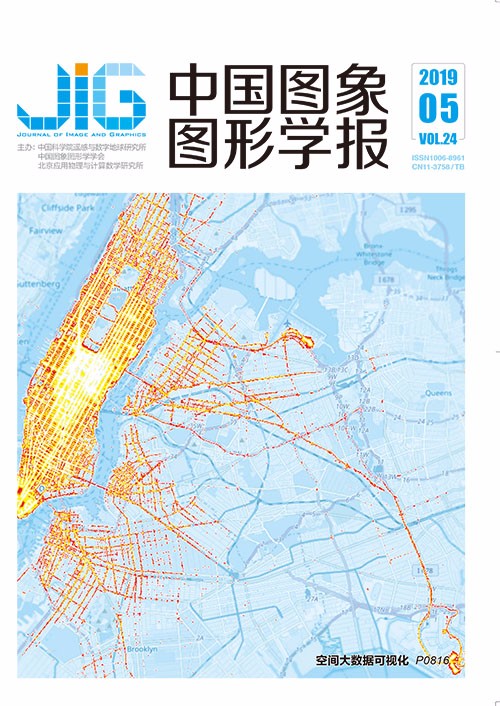
结合流形密度的聚集行为模式分割算法
摘 要
目的 在视频监控和人群模式行为理解的重要应用中,识别分割场景中的集体行为仍然是一个极具挑战性的问题。在这项研究中,提出一种基于流形密度的集体聚类算法,能够识别具有任意形状和不同密度条件下的集体行为的局部和全局模式。方法 受群体运动行为的流形拓扑结构启发,首先提出一种新的流形距离度量方式用于挖掘群体运动的深层行为模式。进一步定义了集体聚集密度的概念,并通过基于聚集密度的聚类算法识别具有局部一致性行为的群组,这种策略更适用于识别具有任意形状的聚类。同时考虑到子群组之间的复杂交互作用,引入层次聚集合并算法得到全局集体行为模式,可以有效地表征全局一致性关系。结果 针对不同情况下的复杂场景,本文算法在集体视频监控数据集下的实验结果表明了其有效性和鲁棒性,相比于传统的聚类方法和标准经典算法,以平均误差(AD)和方差(VAR)作为评价指标来评价算法性能,本文方法将识别分割聚集行为群组的误差率结果控制在了0.81和0.99以内,相比许多经典方法有较大提升。同时在具有复杂流形结构及任意密度条件下的人群场景中能够取得精确有效的识别结果,解决了经典方法在该特殊场景下存在的缺点。结论 本文针对已有方法在流形结构场景识别集体行为流向缺乏精确性和稳定性的描述和分析这一问题,提出了基于流形密度的群组聚集聚类识别算法,在多个复杂真实视频数据集中进行实验,证明了所提方法的有效性,并相比于已有方法具有更高的识别精度。
关键词
Collective motion pattern segmentation algorithm based on manifold density
Wang Luyang1, Lei Jun1, Liang Haozhe2, Zhang Yuqian1, Li Guohui1(1.Science and Technology on Information Systems Engineering Laboratory, National University of Defense Technology, Changsha 410073, China;2.Beijing Institute of System Engineering, Beijing 100101, China) Abstract
Objective Collective motion detection is fundamentally important for analyzing crowd behavior and has attracted considerable attention in artificial intelligence. The recognition and segmentation of collective behavior are important branches of computer vision and graphics, which are significant for public safety, intelligent traffic, and architectural design. The main task of recognizing collective behavior is to mine the coherent patterns consisting of highly coherent tracklets according to the extracted features from crowd motion in videos. However, existing works mostly have limitations due to the insufficient utilization of crowd properties and the arbitrary processing of individuals. Collective behavior involves local and global motion patterns, in which varying densities and arbitrary shapes are salient characteristics. The global coherent motion with complex interaction requires an accurate measurement of local coherency and analysis of global continuity. A further study demonstrates that the motion descriptor and similarity measurement remain limited to finding the latent relativity among tracklet points under the circumstances of perspective distortion and large spatial gap. In view of these shortcomings, we propose the density-based manifold collective clustering approach for detecting groups in crowd scenes. Method Our background modeling is based on the clustering strategy and aims to recognize arbitrarily shaped clusters in coherent motion. Motion features are detected with the generalized Kanade-Lucas-Tomasi feature point tracker, which jointly combines the detecting and tracking stages with efficient computation. The corresponding algorithms mainly include manifold collective density definition, density-based manifold collective clustering, and hierarchical collectiveness merging process. In the first process, a new manifold distance metric is presented to express the intrinsic characteristics of moving individuals. A collective density with novelty is defined based on this topological structure to describe the collectiveness between an individual and its neighbors. This collective density represents the local density efficiently, reflects the global consistency, and is highly adaptive to reveal the underlying patterns of varying densities in coherent motion. We propose a novel collective clustering to find a local topological relationship that can precisely recognize the collectiveness relationship between points and their surroundings. Similar to the core idea of fast search and density peak cluster method, the cluster peak centers of subgroups are assumed to be characterized by a higher collective density calculated by collectiveness than their neighbors. The density-based manifold collective clustering approach is proposed to detect local and global coherent motions with arbitrary shapes and varying densities. Three salient properties must not be ignored:1) the accurate identification of outliers and exploration of manifold structure, 2) the automatic decision of group number without involving any arbitrary threshold, and 3) the capability of dealing with crowd scenes with varying densities. Thus, in the proposed method, the center of collective subgroups is characterized by two criteria:one is a higher collective density than its neighbors, and the other is a relatively large distance and inconsistent orientation from points with a higher density. From this view, the clustering method can determine the cluster centers automatically. In the recognition of global consistency part, inspired by the main ideology of the BIRCH clustering method, a hierarchical collectiveness merging strategy is developed to combine local motions and recognize global consistency. In this process, the collectiveness is used to capture the intracorrelations of subgroups, and local clusters are successfully combined into global coherent groups by merging the highly consistent pairwise subgroups iteratively. Result Collective Motion Database is employed to evaluate the experimental performance, and four state-of-the-art group detection techniques are used for comparison, namely, coherent filtering, collective transition, measuring crowd collectiveness, and collective density clustering. Results show that in complex scenes under different conditions, the experimental results of the algorithm remain highly effective and robust. Compared with the traditional clustering methods and state-of-the-art algorithms, average difference (AD) and variance (VAR) are used as criteria to evaluate the algorithm performance. The AD rate of our proposed method is controlled within 0.81, and the VAR rate is under 0.99, which is approximately 6% lower than those of classical clustering methods. Compared with such classical methods, our method exhibits great improvement. Accurate and effective recognition results can be obtained in crowd scenes with complex manifold structures and arbitrary density conditions, which solve the shortcomings of the classical methods in this special scenario. Conclusion This study proposes a cluster aggregation clustering algorithm based on manifold density for multiple complex real-world videos based on the manifold description and analysis of existing methods for identifying the lack of accuracy and stability of collective behavioral flow in manifold structures. Experiments on various real-world videos and comparisons with previous works validate that our method yields substantial boosts over state-of-the-art competitors. Therefore, the proposed algorithm can have a preferable adaptive performance in complex scenes with varying densities and arbitrary shape situations.
Keywords
coherent motion detection manifold density clustering collective manifold collectiveness motion consistency
|



 中国图象图形学报 │ 京ICP备05080539号-4 │ 本系统由
中国图象图形学报 │ 京ICP备05080539号-4 │ 本系统由